Effects of Subsoiling with Different Wing Mounting Heights on Soil Water Infiltration Using HYDRUS-2D Simulations
Abstract
:1. Introduction
2. Materials and Methods
2.1. Study Site Description
2.2. Experimental Design and Data Collection
2.2.1. Field Experiment
2.2.2. FEM Simulations and Validation
Model Development
- Initial conditions: The model initial conditions consist of the initial soil moisture content, bulk density, and particle size distribution, which were set as the measured data from above field tests (Table 1).
| Soil Conditions before Subsoiling | Soil Density after Subsoiling (g cm−³) | ||||||||
|---|---|---|---|---|---|---|---|---|---|
| Depth (cm) | Moisture Content (%) | Density (g cm−³) | Sand (%) | Silt (%) | Clay (%) | Treatment | Depth (cm) | ||
| 0–10 | 10–20 | 20–30 | |||||||
| 0–10 | 24.2 | 1.356 | 87.10 | 12.10 | 0.80 | h0 | 1.326 | 1.355 | 1.402 |
| 10–20 | 21.5 | 1.454 | 89.23 | 8.05 | 2.72 | h75 | 1.307 | 1.264 | 1.214 |
| 20–30 | 21.6 | 1.482 | 87.93 | 10.03 | 2.04 | h95 | 1.310 | 1.284 | 1.254 |
| 30–40 | 20.4 | 1.490 | 90.40 | 8.15 | 1.45 | h115 | 1.300 | 1.304 | 1.346 |
| 40–60 | 19.8 | 1.511 | 92.06 | 7.06 | 0.88 | h135 | 1.317 | 1.291 | 1.399 |
| 60–80 | 19.5 | 1.491 | 91.32 | 7.50 | 1.18 | h155 | 1.318 | 1.287 | 1.391 |
| 80–100 | 20.7 | 1.534 | 87.01 | 10.45 | 2.54 | ||||
- 2.
- Boundary conditions: A 60 cm wide (i.e., outer diameter of DIM) disturbance area was set as the constant pressure head (5 cm) at the centre of the soil ridge in accordance with the water infiltration test in the field. Atmospheric boundary condition was used for other locations at the soil surface (Figure 3). Both lateral boundaries were considered to be zero flux faces. The bottom boundary was set as a free drainage boundary as the groundwater depth was relatively large (30–50 m) [34] and the groundwater which moved into the test zone was neglected.
- 3.
- Mesh generation: The FE-Mesh module of HYDRUS was used to generate mesh with size of 50 mm (Figure 3C). To improve the accuracy of the model, the triangular mesh size of the disturbed region was appropriately encrypted (i.e., 5 mm). The initial, maximum, and minimum time steps were set as 0.001 min, 10 min, and 0.0001 min, respectively.
- 4.
- Soil hydraulic characteristic parameters: These parameters were determined using the “Rosetta” module of HYDRUS based on the measured soil bulk density and particle sizes at various depths, including residual moisture content, saturated moisture content, reciprocal of air inlet, shape parameter, and saturated hydraulic conductivity.
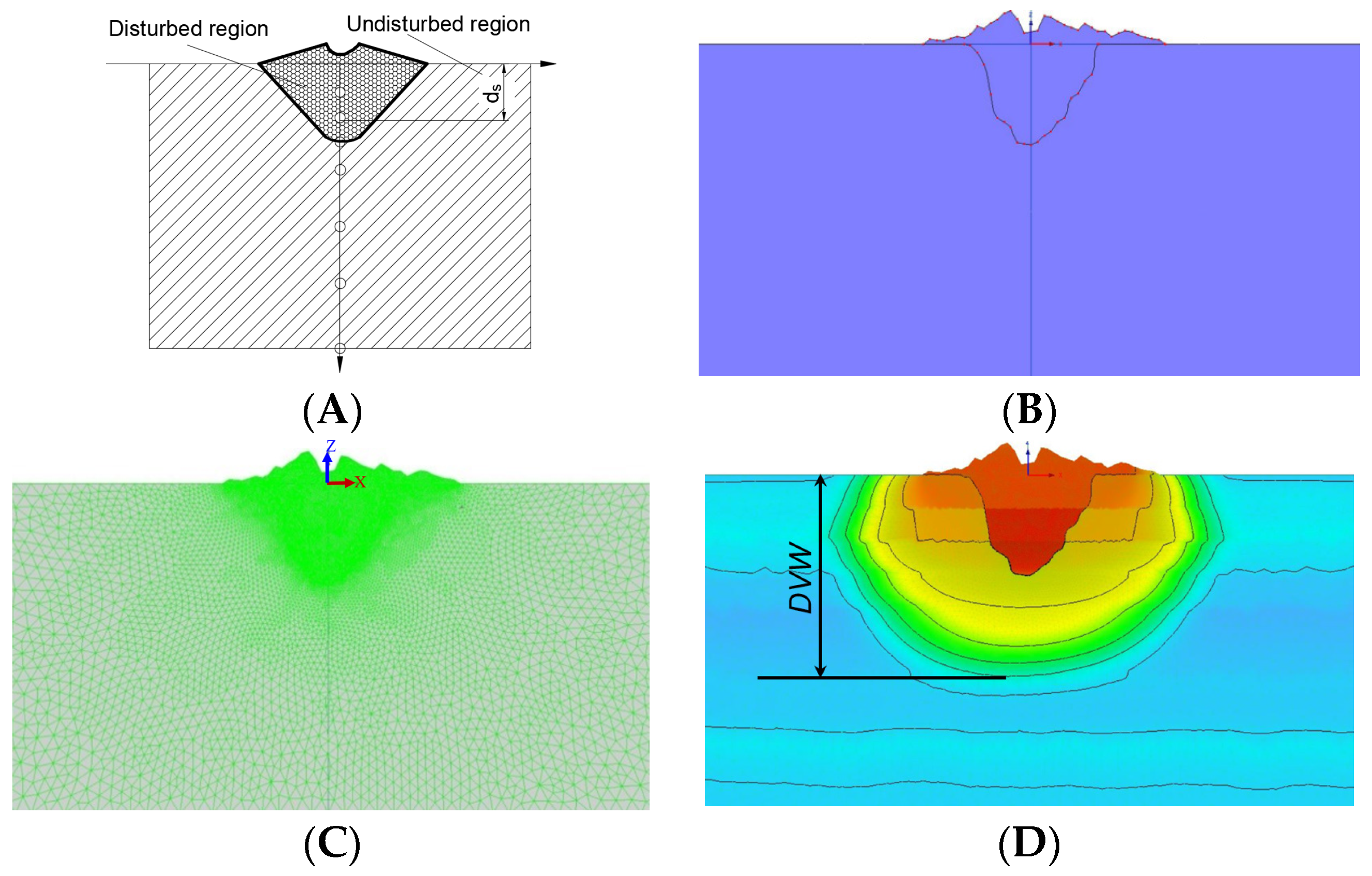
Model Application
Model Validation
3. Results and Discussion
3.1. Effect of Wing Mounting Height (h) on Soil Disturbance Area Ratio
3.2. Effect of Wing Mounting Height on Soil Water Infiltration Rate
(0.0103h + 3.7757)e−[0.5947sin(0.009957h + 0.306) + 0.3819sin(0.2085h + 8.976)]t
3.3. Effect of Wing Mounting Height on Distance of Vertical Wetting Front Movement
0.0781h2 − 16.178h + 124.84
3.4. Effect of Wing Mounting Height on Accumulative Infiltration
+ 3 × 10−7h2 − 5×10−5h − 0.0067
3.5. Effect of Wing Mounting Height on Soil Moisture Content
3.6. Model Validation
4. Conclusions
- Reducing h values gave larger soil disturbance area ratios, soil water infiltration rates f(t), distances of vertical wetting front movement (DVW), accumulative infiltration (AIN), and soil moisture content at depths of 10–30 cm.
- The relationships among characteristics of soil water infiltration, h and time (t), were developed. The stable infiltration rates (fs) varied quadratically with h and the corresponding coefficient of determination (R2) was 0.9869.
- The Horton model is more suitable to describe the relationship between f(t) and t under the tested soil conditions, as compared with the Kostiakov and Philip models.
- Overall, reducing the h can improve the accumulative infiltration (AIN) and distance of vertical wetting front movement (DVW) with an increase in time of water infiltration. The relationships among DVW, wing mounting height (h), and time (t), and among AIN, wing mounting height (h) and time (t) were established.
- According to the results for soil water contents at different depths from FEM simulations and field experiments, RMSEs were lower than 0.05 and R2 values were higher than 0.95, and mean relative errors were less than 12%. The developed soil water infiltration model had a good accuracy.
- Given the fact that increasing the hardpan disturbance by reducing wing mounting height of the subsoiler could improve soil water infiltration characteristics, it is recommended to appropriately reduce the wing mounting height of the subsoiler before subsoiling. It should be noted that the results obtained in this study are limited to only one soil type (Lou soil) and future studies will be needed to consider more soil types.
Author Contributions
Funding
Institutional Review Board Statement
Data Availability Statement
Acknowledgments
Conflicts of Interest
References
- Kuang, N.; Tan, D.; Li, H.; Gou, Q.; Li, Q.; Han, H. Effects of subsoiling before winter wheat on water consumption characteristics and yield of summer maize on the North China Plain. J. Agric. Water Manag. 2020, 227, 105786. [Google Scholar] [CrossRef]
- Wang, X.Z.; Zhou, H.; Wang, S.S.; Zhou, H.M.; Ji, J.T. Methods for reducing the tillage force of subsoiling tools: A review. Soil Till. Res. 2023, 229, 105676. [Google Scholar] [CrossRef]
- Xu, D.; Mermoud, A.J. Topsoil properties as affected by tillage practices in North China. Soil Till. Res. 2001, 60, 11–19. [Google Scholar] [CrossRef]
- Chen, Y.; Cavers, C.; Tessier, S.; Monero, F.; Lobb, D. Short-term tillage effects on soil cone index and plant development in a poorly drained, heavy clay soil. Soil Till. Res. 2005, 82, 161–171. [Google Scholar] [CrossRef]
- Zeng, Z.; Chen, Y.; Zhang, X. Modelling the interaction of a deep tillage tool with heterogeneous soil. Comput. Electron. Agric. 2017, 143, 130–138. [Google Scholar] [CrossRef]
- Spoor, G.; Godwin, R.J. An experimental investigation into the deep loosening of soil by rigid tines. J. Agric. Eng. Res. 1978, 23, 243–258. [Google Scholar] [CrossRef]
- Li, B.; Chen, Y.; Chen, J. Comparison of two subsoiler designs using the discrete element method (DEM). Trans. ASABE 2018, 61, 1529–1537. [Google Scholar] [CrossRef]
- Wang, X.Z.; Yue, B.; Gao, X.; Zheng, Z.; Zhu, R.; Huang, Y. Discrete element simulations and experiments of disturbance behavior as affected by the mounting height of the subsoiler’s wing. Trans. CSAM 2018, 49, 129–141. [Google Scholar] [CrossRef]
- Xia, L. Optimum Parameter and Experimental Study of Shovel Wing Based on Discrete Element Method. Master’s Thesis, Northwest A&F University, Xianyang, China, 2018. [Google Scholar]
- Raper, R.L. Force requirements and soil discruption of straight and bendleg subsoilers for conservation tillage systems. Appl. Eng. Agric. 2005, 21, 787–794. [Google Scholar] [CrossRef]
- Barr, J.B.; Desbiolles, J.M.A.; Fielke, J.M. Minimising soil disturbance and reaction forces for high speed sowing using bentleg furrow openers. Biosyst. Eng. 2016, 151, 53–64. [Google Scholar] [CrossRef]
- Huang, Y.; Hang, C.; Yuan, M.; Wang, B.; Zhu, R. Discrete element simulations and experiments on disturbance behavior of subsoiling. Trans. CSAM 2016, 47, 80–88. [Google Scholar] [CrossRef]
- Hang, C.; Huang, Y.; Zhu, R. Analysis of the movement behaviour of soil between subsoilers based on the discrete element method. J. Terramech. 2017, 74, 35–43. [Google Scholar] [CrossRef]
- Hang, C.; Gao, X.; Yuan, M.; Huang, Y.; Zhu, R. Discrete element simulations and experiments of soil disturbance as affected by the tine spacing of subsoiler. Biosyst. Eng. 2018, 163, 73–82. [Google Scholar] [CrossRef]
- Argyrokastritis, I.; Psychogiou, M.; Londra, P.A. Infiltration under ponded conditions. Water 2021, 13, 3492. [Google Scholar] [CrossRef]
- Ommi, S.H.; Sciarra, G.; Kotronis, P. A phase field model for partially saturated geomaterials describing fluid–fluid displacements. Part I: The model and one-dimensional analysis. Adv. Water Resour. 2022, 164, 104170. [Google Scholar] [CrossRef]
- Qiao, Z.R.; Wu, L.F.; Yang, Z.Z. Prediction of water consumption in 31 provinces of China based on FGM(1,1) model. Clean Soil Air Water 2022, 50, 2200052. [Google Scholar] [CrossRef]
- Yang, P.; Cheng, M.H.; Wu, L.F.; Fan, J.L.; Li, S.; Wang, H.D.; Qian, L. Review on drip irrigation: Impact on crop yield, quality, and water productivity in China. Water 2023, 15, 1733. [Google Scholar] [CrossRef]
- Ma, Y.; Feng, S.; Su, D.Y.; Gao, G.Y.; Huo, Z.L. Modeling water infiltration in a large layered soil column with a modified Green–Ampt model and HYDRUS-1D. Comput. Electron. Agric. 2010, 71 (Suppl. S1), S40–S47. [Google Scholar] [CrossRef]
- Mishra, S.K.; Kumar, S.R.; Singh, V.P. Calibration and validation of a general infiltration model. Hydrol. Process. 1999, 13, 1691–1718. [Google Scholar] [CrossRef]
- Arampatzis, G.; Tzimopoulos, C.; Sakellariou-Makrantonaki, M.; Yannopoulos, S. Estimation of unsaturated flow in layered soils with the finite control volume method. Irrig. Drain. 2001, 50, 349–358. [Google Scholar] [CrossRef]
- Ebrahimian, H.; Liaghat, A.; Parsinejad, M.; Abbasi, F.; Navabian, M. Comparison of one- and two-dimensional models to simulate alternate and conventional furrow fertigation. J. Irrig. Drain. Eng. 2012, 138, 929–938. [Google Scholar] [CrossRef]
- Yao, Y.X. Numerical Simulation and Experimental Study of Soil Water Infiltration in Subsoil Tillage. Master’s Thesis, Northwest A&F University, Xianyang, China, 2019. [Google Scholar]
- Karandish, F.; Simunek, J. A comparison of the HYDRUS (2D/3D) and SALTMED models to investigate the influence of various water-saving irrigation strategies on the maize water footprint. Agric. Water Manag. 2019, 213, 809–820. [Google Scholar] [CrossRef]
- Chen, Y.; Tessier, S. Techniques to diagnose plow and disk pans. Can. J. Agric. Eng. 1997, 39, 143–147. [Google Scholar]
- Atwell, B.J. Response of roots to mechanical impedance. Environ. Exp. Bot. 1993, 33, 27–40. [Google Scholar] [CrossRef]
- Letey, J. Relationship between soil physical properties and crop production. Adv. Soil Sci. 1995, 1, 227–294. [Google Scholar] [CrossRef]
- Francis, G.S.; Cameron, K.C.; Swift, R.S. Soil physical conditions after six years of direct drilling or conventional cultivation on silt loam soil in New Zealand. J. Soil Res. 1987, 25, 517–520. [Google Scholar] [CrossRef]
- Chen, Y.; Munkholm, L.J.; Nyord, T. A discrete element model for soil-sweep interaction in three different soils. Soil Till. Res. 2013, 126, 34–41. [Google Scholar] [CrossRef]
- Wang, X.Z.; Fu, Z.L.; Zhang, Q.K.; Huang, Y.X. Short-term subsoiling effects with different wing mounting heights before winter wheat on soil properties and wheat growth in Northwest China. Soil Till. Res. 2021, 213, 105151. [Google Scholar] [CrossRef]
- Liu, H.H.; Wang, G.L.; Yin, H.S. Characteristics of soil water infiltration under different vegetation cover in jujube economic forest. J. Irrig. Drain. 2020, 39, 54–60. [Google Scholar] [CrossRef]
- Ren, Z.P.; Zhang, H.H.; Wang, B. Effect of double ring diameter on soil infiltration rate. J. Soil. Water Conserv. 2012, 26, 94–97. [Google Scholar]
- Fu, Q.; Li, Y.; Li, T.X.; Cui, S.; Liu, D.D. HYDRUS simulation verification and influencing factors analysis of channel leakage. Trans. CSAE 2017, 33, 112–118. [Google Scholar] [CrossRef]
- Zhu, X.M. Soil and Agriculture on the Loess Plateau; Agriculture Press: Beijing, China, 1989. [Google Scholar]
- Zhang, J.; Wei, Z.M.; Zhang, J.D.; Su, R.N. Channel leakage simulation and analysis of influencing factors based on HYDRUS model. J. Water Soil. Conserv. 2020, 34, 141–148. [Google Scholar]
- Zhang, Y.Y. Simulation of Soil Water Infiltration for Ridge Irrigation. Ph.D. Thesis, Graduate School of Chinese Academy of Sciences (Research Center of Soil and Water Conservation and Ecological Environment, Ministry of Education), Xianyang, China, 2013. [Google Scholar]
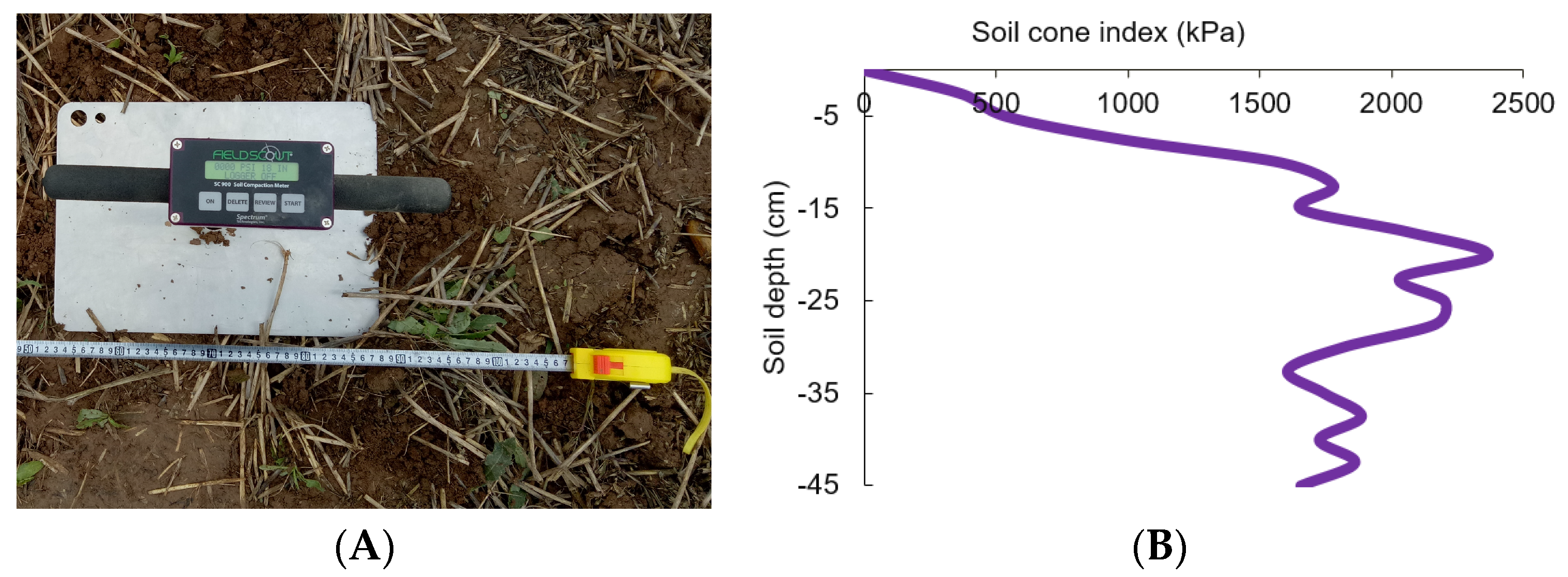
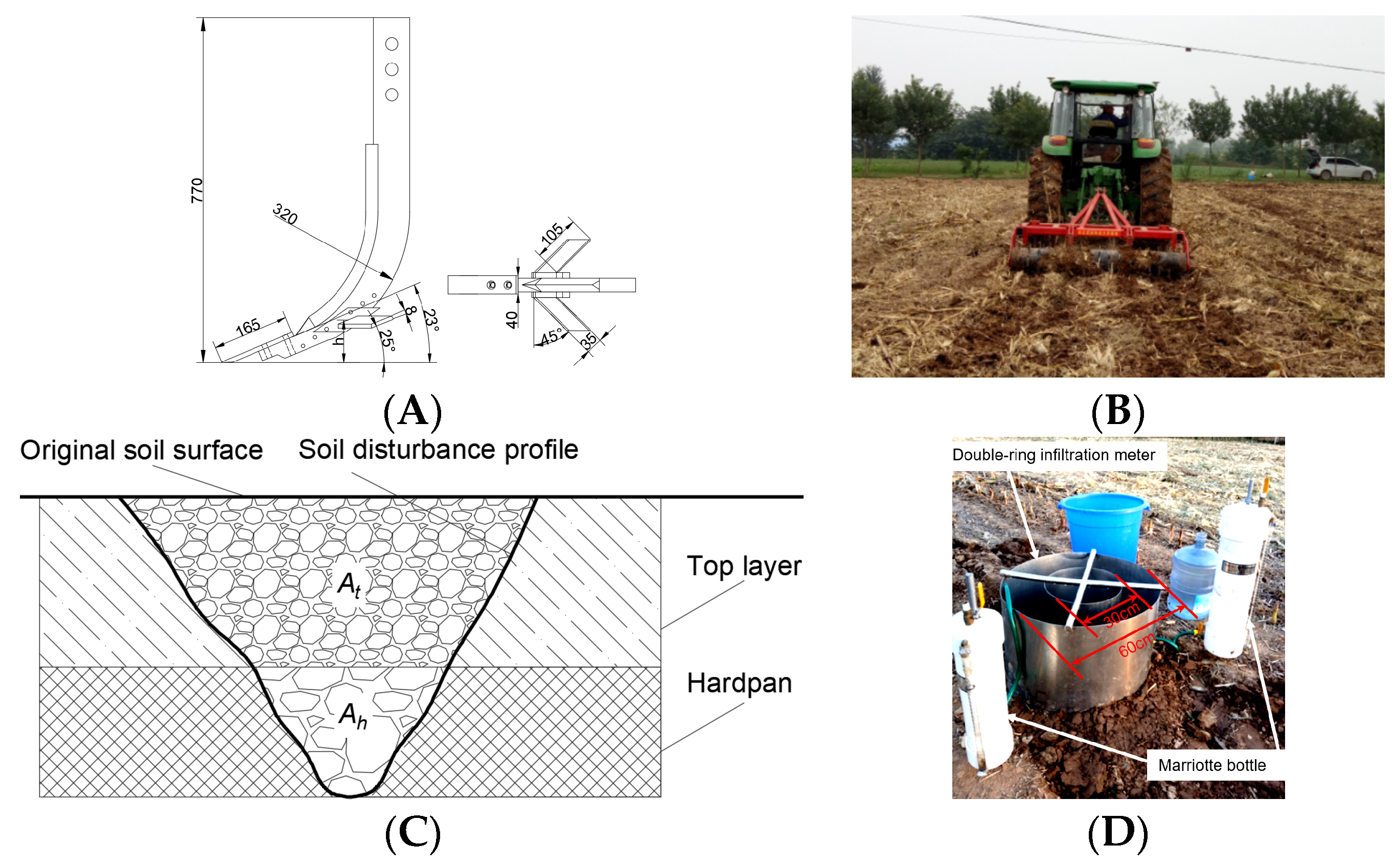

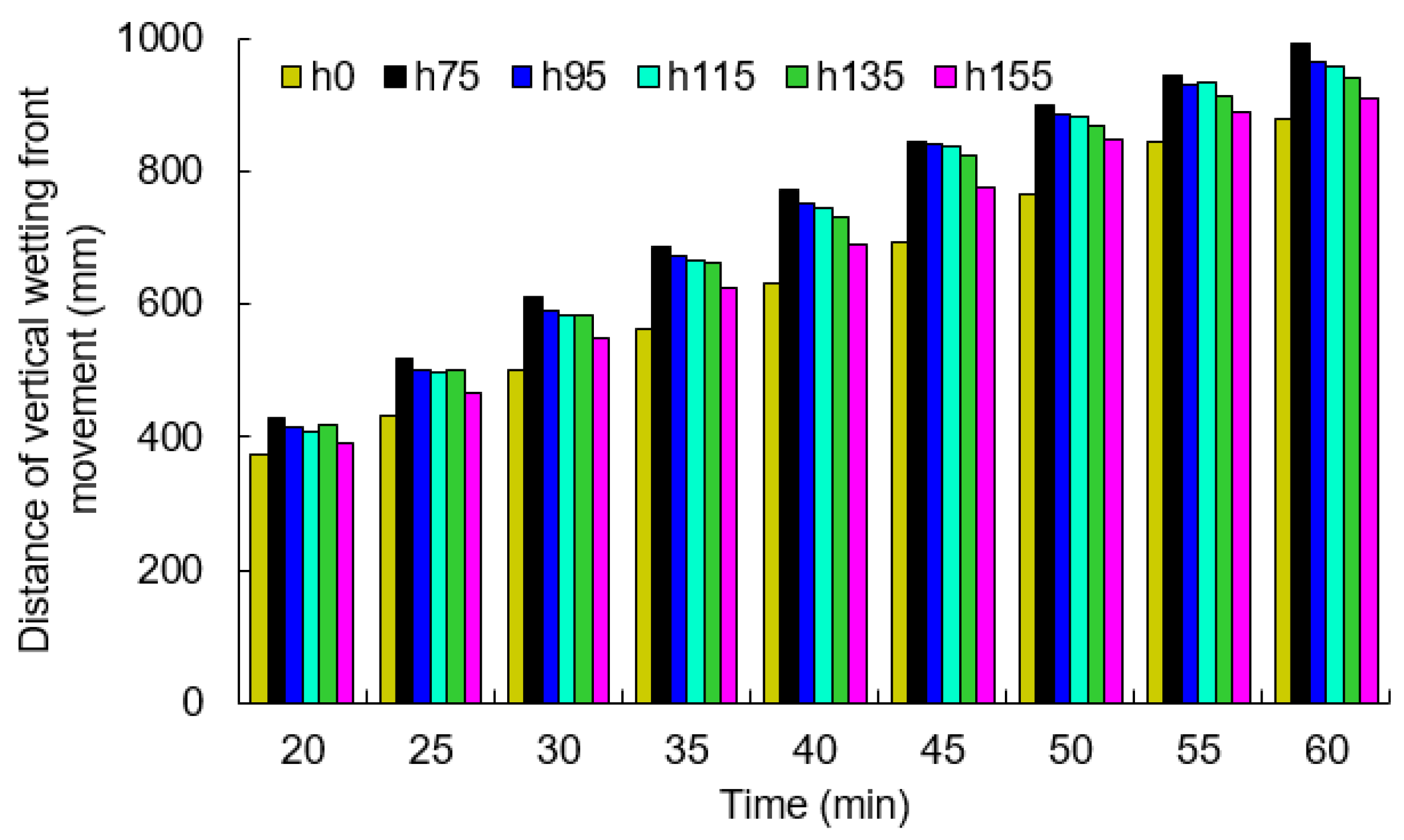
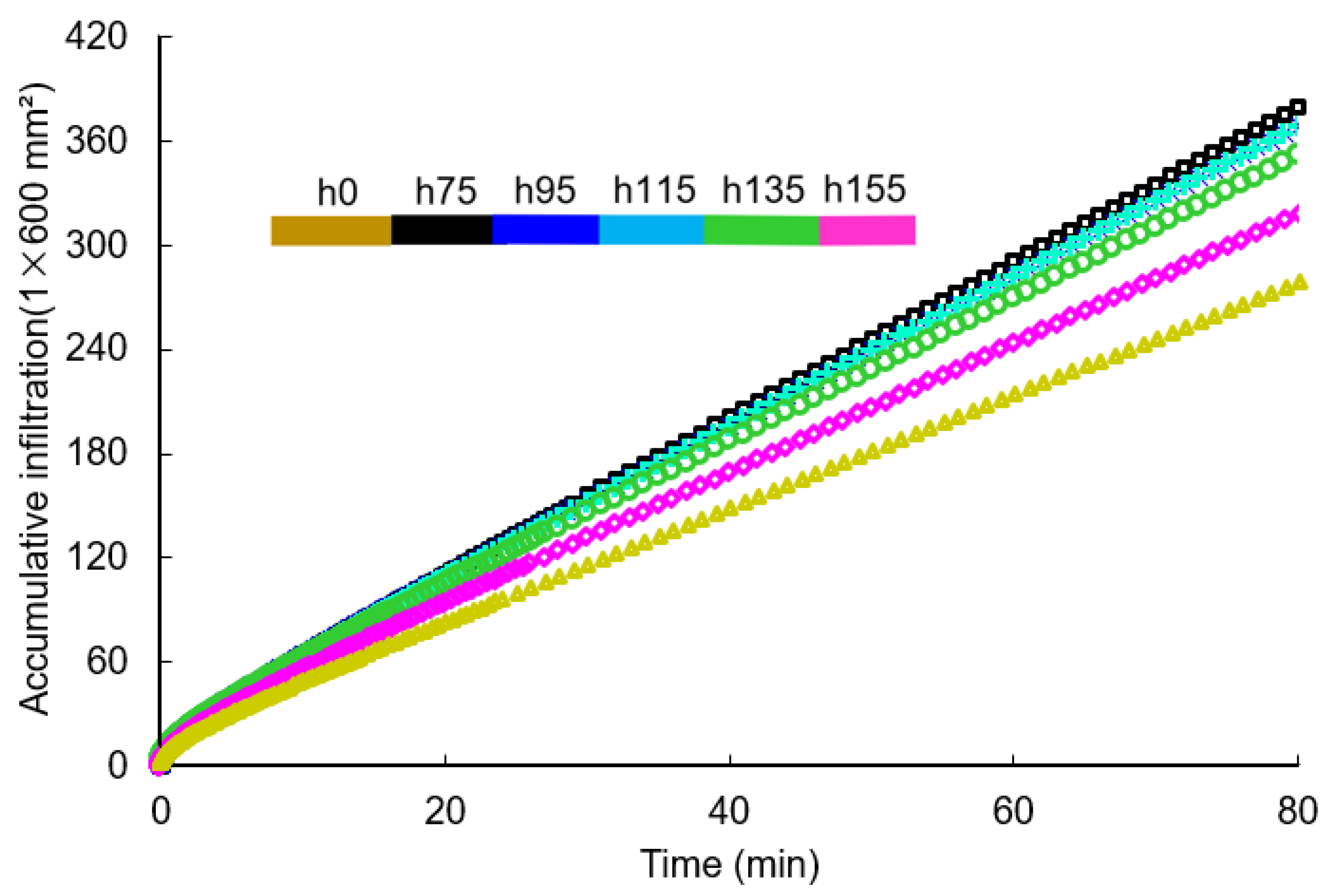
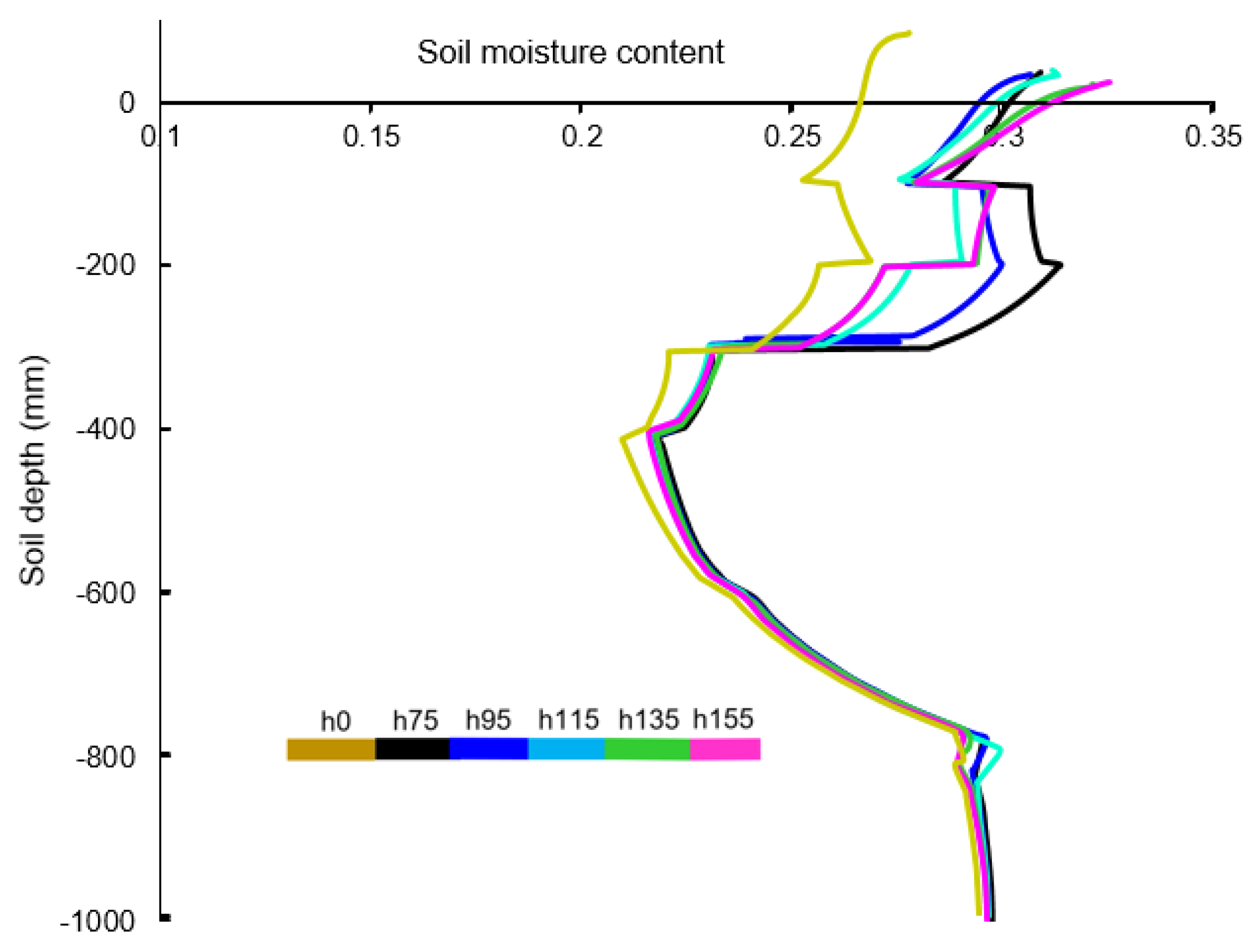
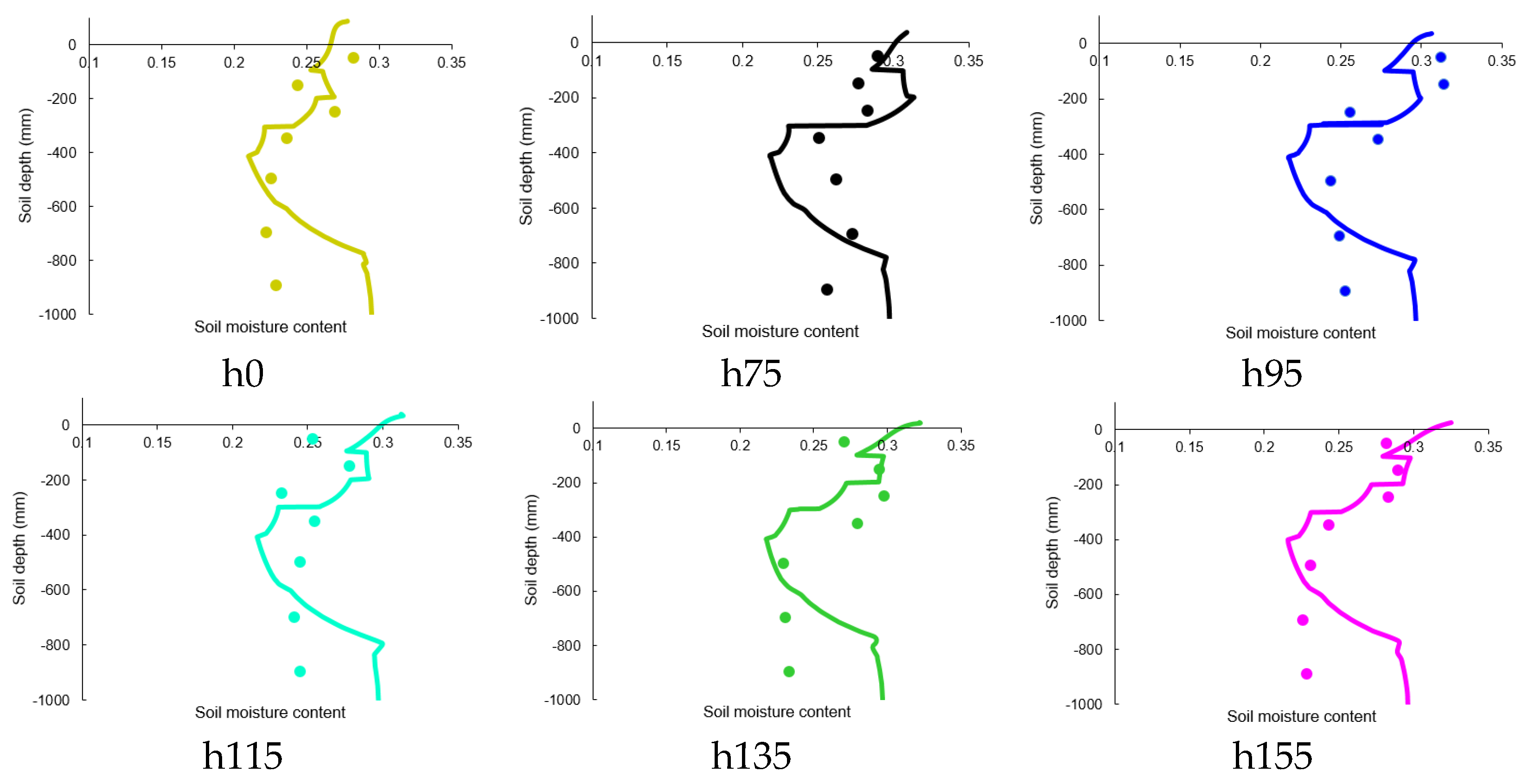
| Treatment | Kostiakov | Philip | Horton | |||||||
|---|---|---|---|---|---|---|---|---|---|---|
| ϛ | ϵ | R2 | υ/ (mm/min) | fs/ (mm/min) | R2 | fs/ (mm/min) | Δf/ (mm/min) | Γ | R2 | |
| h0 | 5.138 | 0.123 | 0.834 | 6.356 | 2.725 | 0.962 | 3.277 | 3.739 | 0.345 | 0.979 |
| h75 | 6.723 | 0.116 | 0.831 | 7.824 | 3.75 | 0.963 | 4.470 | 4.331 | 0.326 | 0.968 |
| h95 | 6.793 | 0.129 | 0.824 | 8.542 | 3.524 | 0.955 | 4.328 | 5.200 | 0.380 | 0.972 |
| h115 | 6.660 | 0.123 | 0.827 | 8.066 | 3.566 | 0.959 | 4.314 | 4.808 | 0.366 | 0.972 |
| h135 | 6.646 | 0.135 | 0.834 | 8.606 | 3.311 | 0.958 | 4.111 | 5.267 | 0.383 | 0.980 |
| h155 | 6.035 | 0.138 | 0.815 | 8.130 | 2.936 | 0.947 | 3.708 | 5.220 | 0.407 | 0.980 |
| Fitted Equations | R2 |
|---|---|
| fs(h) = −0.0002h2 + 0.0264h + 3.2815 | 0.987 |
| Δf(h) = 0.0103h + 3.7757 | 0.839 |
| Γ(h) = 0.5947sin(0.009957h + 0.306) + 0.3819sin(0.2085h + 8.976) | 1.000 |
| Treatment | b1 | b2 | b3 | R2 |
|---|---|---|---|---|
| h0 | 121.37 | −4.35 | 13.42 | 1.000 |
| h75 | −629.50 | 268.57 | −7.53 | 0.998 |
| h95 | −702.22 | 288.45 | −9.22 | 0.996 |
| h115 | −744.81 | 299.94 | −10.06 | 0.995 |
| h135 | −618.04 | 264.51 | −7.89 | 0.995 |
| h155 | −502.89 | 213.77 | −3.70 | 0.994 |
| Fitted Equations | R2 |
|---|---|
| b1(h) = 0.0781h2 − 16.178h + 124.84 | 0.995 |
| b2(h) = −0.0284h2 + 5.8292h − 5.2937 | 0.998 |
| b3(h) = 0.0021h2 − 0.4463h + 13.512 | 0.999 |
| Treatment | Fitted Equations | R2 |
|---|---|---|
| h0 | AIN = −0.0067t2 + 3.9004t + 6.0851 | 0.999 |
| h75 | AIN = −0.0091t2 + 5.2844t + 8.3945 | 0.999 |
| h95 | AIN = −0.0093t2 + 5.1688t + 8.7256 | 0.998 |
| h115 | AIN = −0.0089t2 + 5.1218t + 8.366 | 0.999 |
| h135 | AIN = −0.0087t2 + 4.9069t + 8.5697 | 0.998 |
| h155 | AIN = −0.0081t2 + 4.4461t + 8.2953 | 0.998 |
| Item | h0 | h75 | h95 | h115 | h135 | h155 |
|---|---|---|---|---|---|---|
| RMSE | 0.032 | 0.026 | 0.031 | 0.032 | 0.036 | 0.031 |
| R2 | 0.948 | 0.982 | 0.970 | 0.964 | 0.956 | 0.968 |
| Mean relative error (%) | 11.03 | 8.19 | 10.58 | 11.87 | 11.38 | 9.9 |
Disclaimer/Publisher’s Note: The statements, opinions and data contained in all publications are solely those of the individual author(s) and contributor(s) and not of MDPI and/or the editor(s). MDPI and/or the editor(s) disclaim responsibility for any injury to people or property resulting from any ideas, methods, instructions or products referred to in the content. |
© 2023 by the authors. Licensee MDPI, Basel, Switzerland. This article is an open access article distributed under the terms and conditions of the Creative Commons Attribution (CC BY) license (https://creativecommons.org/licenses/by/4.0/).
Share and Cite
Wang, X.; Geng, L.; Zhou, H.; Huang, Y.; Ji, J. Effects of Subsoiling with Different Wing Mounting Heights on Soil Water Infiltration Using HYDRUS-2D Simulations. Agronomy 2023, 13, 2742. https://doi.org/10.3390/agronomy13112742
Wang X, Geng L, Zhou H, Huang Y, Ji J. Effects of Subsoiling with Different Wing Mounting Heights on Soil Water Infiltration Using HYDRUS-2D Simulations. Agronomy. 2023; 13(11):2742. https://doi.org/10.3390/agronomy13112742
Chicago/Turabian StyleWang, Xuezhen, Lingxin Geng, Hanmi Zhou, Yuxiang Huang, and Jiangtao Ji. 2023. "Effects of Subsoiling with Different Wing Mounting Heights on Soil Water Infiltration Using HYDRUS-2D Simulations" Agronomy 13, no. 11: 2742. https://doi.org/10.3390/agronomy13112742
APA StyleWang, X., Geng, L., Zhou, H., Huang, Y., & Ji, J. (2023). Effects of Subsoiling with Different Wing Mounting Heights on Soil Water Infiltration Using HYDRUS-2D Simulations. Agronomy, 13(11), 2742. https://doi.org/10.3390/agronomy13112742






